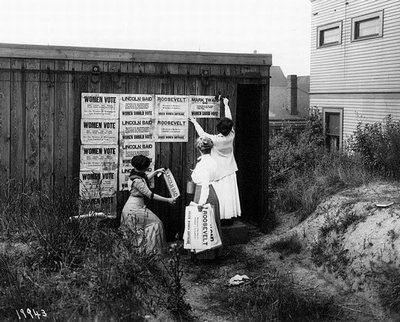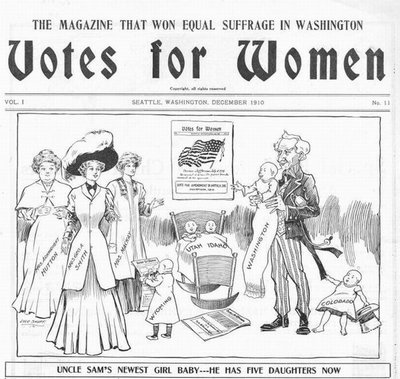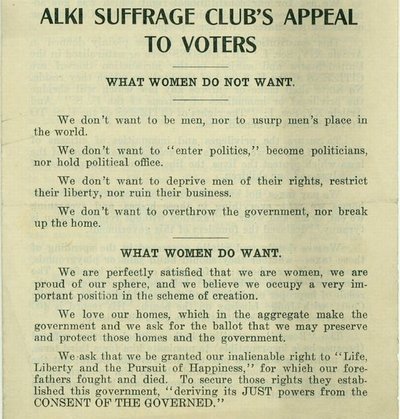November 4, 2010
UW Women’s Center, state to celebrate women’s suffrage — 100 years later
Note from 2021: The 19th Amendment did not affirmatively grant the right to vote to all women. Many voter suppression tactics still existed and were being used to deny voting rights to Black women — and men — even after the 19th Amendment was ratified. The same tactics were used against Latina, Indigenous and Asian American women.

Members of college suffrage clubs were active in putting up posters supporting women’s right to vote.
On Nov. 2, 2010, the Washington ballot included the name of a woman running for re-election as a United States senator. On Nov. 2, 1910, a woman could not have voted in the election, let alone run for office. But just six days later, on Nov. 8, the male voters of Washington ratified an amendment to Article VI of the state constitution, granting women the right to vote.
The UW Women’s Center will celebrate the centennial of that event with a gala on Saturday, Nov. 6, while at the state capitol in Olympia, a two-day celebration is planned Nov. 7 and 8. And on Friday, Nov. 19, Shanna Stevenson, the coordinator for the Washington Women’s History Consortium, will speak on campus about the suffrage movement in the state.
It was a movement that lasted more than 50 years as women gained the right to vote, only to have it taken away again not once but three times before they were finally successful. Even so, women’s suffrage in Washington was granted 10 years before a similar amendment to the U.S. Constitution was ratified.
According to Stevenson’s Book, Women’s Votes, Women’s Voices, The first attempt at women’s suffrage in Washington came in 1854, when Arthur Denny, a representative to the Washington Territorial Legislature, proposed that a pending bill on voting be amended to allow “all white females over the age of 18 years” to vote. His proposal was defeated, and the vote was restricted to men. But in 1867, another legislator convinced his colleagues to remove the word “male” from the voting laws.
Women reasonably concluded that they had the right to vote, but when some of them tried it, their ballots were rejected. And in 1871, the Legislature enacted a law stating that women in Washington could not have the right to vote until the U.S. Congress made it the “supreme law of the land.”
By that time, women in the state had formed suffrage associations, and they continued to agitate for voting rights. They won them in 1883, but in 1887, the right of women to serve on juries was questioned. The Territorial Supreme Court ruled that women were not legal jurors and revoked the 1883 law. It was re-enacted by the governor in 1888, but the court again overturned it later that year.
Other attempts were made to win the vote in the 1890s but they failed, and as the 20th century dawned, the Washington Equal Suffrage Association had nearly disbanded. That’s when a campaign was mounted that was ultimately successful.
“Washington’s campaign is widely noted as very pivotal in the suffrage story because it had been 14 years since any state had enacted women’s right to vote [Idaho, 1896] and we were the first in the 20th century,” said Stevenson, who spoke by phone from her office in Olympia. “The suffrage movement was in the doldrums at the turn of the century, so watching Washington’s victory was very reinvigorating for the national campaign.”

This cartoon, which appeared in a suffrage publication, celebrated Washington as the fifth state to grant women the right to vote.
According to Stevenson, the Washington campaign was quite modern. “The suffragists were very strategic; you might say they stayed on message,” she said. “They were very much concerned with one message, which was, ‘It’s a matter of justice that women have the right to vote.’ They also formed coalitions with labor and the Grange and the Farmer’s Union to strengthen their campaign. They were very active in reaching out to voters.”
The campaign was deliberately low key, Stevenson said, eschewing the confrontational tactics of suffragists elsewhere. The women even published a cookbook as a fundraiser, thus stressing their domesticity.
When the Alaska Yukon Pacific Exposition was being planned for the UW campus in 1909, suffragists arranged for the National American Woman Suffrage Association to hold its convention in Seattle, and July 7, 1909, was declared Woman Suffrage Day at the exposition. Because Cunningham Hall was then the Women’s Building, it was the site of some of the suffragists’ planning meetings.
Today it is the home of the UW Women’s Center, and the staff there wanted to celebrate the accomplishments of the suffragists and other outstanding Washington women with a gala. More than 500 people are expected for a dinner at the Seattle Sheraton.
“We are honoring 100 women who were pioneers in breaking through barriers and opening doors for girls and women,” said Women’s Center Director Sutapa Basu. “They will be recognized at the gala for all they have done.”
Of the 100, 54 are still alive, and between 40 and 45 of these are expected to attend. Women’s Center co-founder Alene Moris will speak, and there will be a silent auction to raise funds for the Women’s Center. A donor has pledged $25,000 if the center can match it. And the honorees will be serenaded with a rendition of Aretha Franklin’s Respect performed by local singer Josephine Howell.
“My staff tells me it’s going to bring the house down,” Basu said.
Meanwhile in Olympia, a suffrage centennial tea is planned on Sunday, Nov. 7, at the State Capitol Museum.
“That’s part of the traditional way women got together at that time,” Stevenson said. “The tea will feature some women role playing the suffragists, who will be on the edge of their teacups wondering what the results of the vote the next day will be.”
On Nov. 8, an all-day celebration is planned at the Capitol campus. There will be a fashion show, theatrical performances and music of the period. Then at 4 p.m. there will be a formal program hosted by Secretary of State Sam Reed. Reed will re-enact the reading of the results of the election as it would have been on Nov. 8, 1910.
“For the fun part of it, we learned from a contemporary account that the women of Washington passed along a banner with good wishes to the women of California—the next state that had the suffrage enactment,” Stevenson said. “So we’re reenacting that. We’re passing a banner to the suffrage centennial committee from California who are coming up for the festivities. The committee from Oregon and Oregon’s secretary of state are also coming.”
The Women’s History Consortium has a traveling exhibit about women’s suffrage in Washington, and the UW Libraries has hosted several exhibits. One, A Ballot for the Ladies, was created by recent ISchool graduate Kylie Fullmer and was displayed in the lobby outside Special Collections. It lives on in virtual form. The exhibit traces the fight for suffrage from the first attempts to final victory, and includes photos and artifacts from the time.
Washington was the fifth state in the nation to grant voting rights to women, preceded by Wyoming, Colorado, Utah and Idaho. Women in those states and the other, mostly western, states that followed played a prominent role in the fight for national suffrage, Stevenson said.
She promises to bring interesting images from the traveling exhibit when she comes to campus Nov. 19. Sponsored by UW Women Studies and UW Women’s Center, the presentation is at 12:30 p.m. in 403 Electrical Engineering Building. It is free and open to the public.

